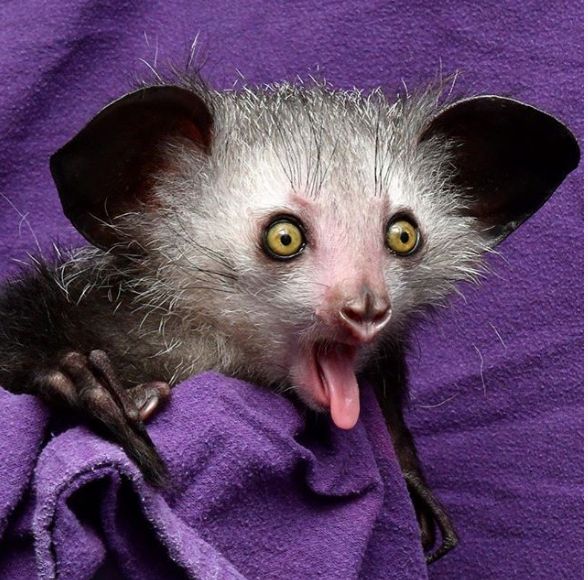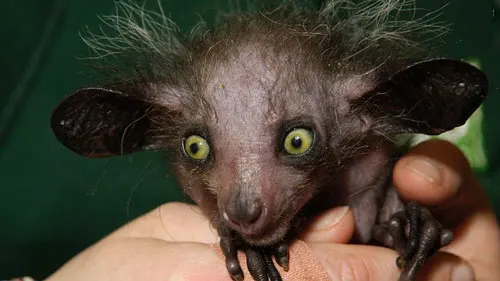Variety Overview
The Aye-aye (Scientific name: Daubentonia madagascariensis) is named for its notably long fingers and toes, particularly its middle finger. This creature resembles a large rat with a body length ranging from 36-44 cm, a tail length of 50-60 cm, and a weight of around 2 kg. Its fur is coarse and long, varying from dark brown to black. The tail is longer than its body and bushy like a broomstick with hair up to 10 cm long in black or gray shades. The aye-aye has a slender build with a large head featuring a blunt snout and large membranous ears. Except for its thumbs and big toes which have flat nails, all other fingers and toes end in sharp claws. Its teeth structure is similar to that of rodents with only 20 teeth in total. The limbs are short with legs being longer than arms.
Aye-ayes inhabit tropical rainforests where they live on large tree branches or trunks, building spherical nests in tree hollows or forks. They live solitarily or in pairs and are nocturnal creatures that prefer eating insects. During feeding, they often tap tree bark with their middle finger to check for hollows inside before listening closely for insect sounds. If they detect any insects, they gnaw a small hole into the bark using their incisors and extract the insects using their middle finger. Due to their eerie cries that resemble wails, locals believe aye-ayes bring bad luck and kill them on sight. Combined with habitat destruction, this has made aye-ayes extremely rare; they were once even thought to be extinct. They are found along the eastern coastal forests of Madagascar.
Latin Name: Daubentonia madagascariensis
Kingdom: Animalia
Phylum: Chordata
Subphylum: Vertebrata
Class: Mammalia
Order: Primates
Family: Daubentoniidae
Genus: Daubentonia
Species: D. madagascariensis
Namer & Year Described: Gmelin, 1788
English Name: Aye-aye
Design Characteristics
The aye-aye (Daubentonia madagascariensis) measures between 30-38 cm in body length, has a tail length of 44-51 cm, and weighs around 2-3 kg. It features a large but relatively flat head with a fox-like face. Its snout is prominent yet blunt, complemented by large black ears that are highly mobile and membranous. The aye-aye’s body is slender with short limbs where the legs are longer than the arms. Except for its thumbs and big toes which have flat nails, all other digits possess sharp claws. Its fur is predominantly black-brown made up of short soft underfur combined with long coarse guard hairs; its muzzle and lower body display grayish-white fur while facial fur has white bases with particularly long neck fur tipped in white. The tail exceeds body length with fluffy dense hair resembling a broom up to 10 cm long appearing either black or gray.
Active during nighttime hours marked by glaring orange-yellow eyes along with a cat-like build paired bat-like ears; squirrel-like teeth & claws plus human-like hands define an aye-aye’s distinct appearance using these hands tapping trees identifying larval presence within them due peculiar wire-thin middle & ring fingers aiding extraction from bark crevices or scooping fruit flesh post gnawing shell open.
Another unique trait resides within their dental structure having merely twenty teeth lacking primitive monkeys’ comb-like ones being sole primate devoid canines instead possessing continuously growing incisors equipped enamelled surfaces bearing sharp cutting edges leading historical misclassification under rodents category spanning several years.

Living Habits
Inhabit the branches or trunks of large trees in tropical rainforests, building spherical nests in tree holes or forks. Different individuals occupy different nests over consecutive days. They come out alone or in pairs at night and hide in trees to sleep during the day. Aye-ayes move quadrupedally and hop on all fours when they descend to the ground.
When foraging, aye-ayes utilize their unique fingers to extract insect eggs from tree trunks, scoop coconut meat from shells, drink egg whites from eggshells, and consume bark and bamboo shoots. Since aye-ayes primarily feed on insect eggs found beneath tree bark or on dead wood, they serve a role similar to woodpeckers as “doctors of the trees.” While woodpeckers inhabit mainland Africa near Madagascar, aye-ayes fulfill this ecological niche on Madagascar itself.
When an aye-aye feeds, it often taps on tree bark with its middle finger to check for hollows and then listens closely for any insect sounds. If it detects insects, it uses its incisors to gnaw a small hole in the bark and extracts the insect with its middle finger. Similarly, when eating berries, it pokes a hole in the fruit with its middle finger and scoops out the pulp.
At night, accompanied by eerie calls of “aye-aye,” these mysterious creatures come out. These distinctive calls have earned them their English name “Aye-aye.” Generally peaceful, they only make gurgling noises when disturbed. However, during feeding times, they abandon all decorum; an aye-aye munching on fruit will chew loudly with juice splattering everywhere and saliva dripping freely.
Hunting for small insects hidden in tree crevices is second nature to an aye-aye. It begins by lightly walking along the trunk with its nose close to the bark. Upon hearing or smelling something interesting, it stops to observe closely before vigorously gnawing at the bark until it uncovers a concealed grub. The aye-aye then extends its finger to crush and eat the grub.
The aye-aye prefers to consume insect larvae, small beetles, and bird eggs but avoids larger insects. Its diet also includes sugarcane, mangoes, and cocoa. With its powerful teeth, the aye-aye can crack open the hard shells of fruits such as coconuts. When kept in captivity, it additionally eats bananas, dates, and eggs.
